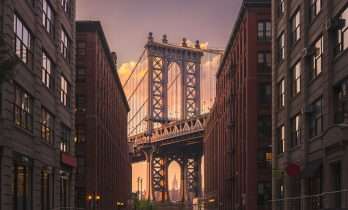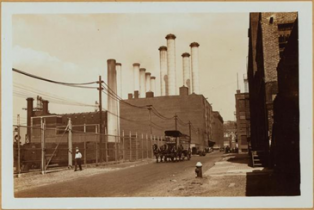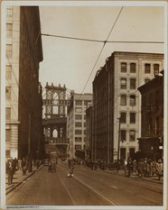History And More

DUMBO, Down Under the Manhattan Bridge Overpass, is one of the fastest-growing neighborhoods in all of America. It is right on the water with a fantastic view of both the Brooklyn Bridge, the Manhattan Bridge, and the best skyline in the world. The location on the water led to it starting as basically an industrial wasteland. But after decades of renovation, it is now home to one of the most expensive apartments in all of New York: The Clock Tower Condominium. This can be attested to a large number of high-quality restaurants and even art galleries that have been added. This intense turnover has left the area as an influencer-heavy hotspot that has become one of the City’s icons.
The history of Brooklyn starts in DUMBO due to its proximity to Manhattan. Dating back to the 1600s. It had many names before that such as Rapailie, Olympia, Walentasville, and Fulton Landing. The Olympia name was coined in 1787 by the brotherly duo of Joshua and Comfort Sands, one of the founding families of Sands Point, New York[1]. Another example of the development of DUMBO is that it originally was never the main attraction because it was part of the much larger Vinegar Hill. At this time, Vinegar Hill was an extremely busy shipyard that included warehouses as well as the houses of the workers there[2]. The sands brothers had the bold idea of making this land a summer getaway for all New Yorkers[3]. This area has been home to some of the most important moments in New York City History. For example, in 1776 George Washington took what became coined The Brookland Ferry Landing[4]. Also, on what is current day Doughty Street, Charles Doughty took the moral challenge and freed his slave in 1797 before he started his journey to eradicate all slavery in New York State. At this time, the biggest part of Fulton Landing was by far the lucrative ferry business.[5]

For around 60 years, right next to DUMBO was the busy Fulton Ferry section. This was popular for its convenience to the water which led to the area being used simply for ferrying purposes, meaning many of the inhabitants were farmers and travelers. The main bulk of their livelihood would be from boats that would hold produce, people, and even farm animals.[6] The popularity of this commerce led to it becoming an immensely attractive area for all kinds of people. Ferry Landing became the home of many factories that produced anything from machinery to Brillo soap pads. This was also the site of the cardboard box invention by Robert Gair, who eventually got a building and a whole section of Ferry Landing named after him in his honor. The most active part was the main strip titled Front Street. This street was packed with businesses of all kinds such as banks, warehouses, and even insurance companies. Many of these buildings hold their rich history and are still there to this day! One of the most notable ones is the current day Gran Eléctrica restaurant. This building was originally the site of the Long Island Insurance Company where Mayor Henry C. Murphy worked tirelessly to ensure the legality of the Brooklyn Bridge construction in the early 1880s.[7] Before the Brooklyn Bridge, the main industry of this area was the warehouses, shops, and the booming ferry business. The bridge was the first major challenge that this area had to undertake. This was because they were always able to rely so heavily on being supported by travelers being ferried over to Manhattan. Once the Brooklyn bridge came along, they needed to find new ways to sustain themselves in the hostile environment that is New York City.
The bridge was completed in 1883 and the neighborhood started to see the ramifications immediately. By the mid-1900s the aforementioned shipbuilding industry was no longer profitable, and the area became ravaged, it was the fall of a titan. It stayed this way until the mid-to-late twentieth century when city planners knew something had to be done. It was at this moment that they took inspiration from the booming neighborhood of Soho2. New York City had decided earlier to allow established artists to move into abandoned industrial lofts. It was these artists that came up with the name DUMBO as a sort of playful and marketable name. The first domino to fall was David Walentas and his Two Trees Development Corporation. This real estate developer was known for his prominent expansions of both Soho and Noho with his partner J. Fredric Byers III. Unfortunately, in 1978 his Partner Byers died, but that fueled Walentas to continue their passionate journey to evolve New York City[8] [9]. After being vetted by multiple investors, he was able to get the funding to purchase two million square feet of land within the area, which was almost the whole neighborhood. His original plan, which fell through thanks to a buyout from American Express, was to develop the buildings into Wall Street offices to bring in a wealthier clientele3. Walentas did not have many options as the entire area was under an industrial zone, making it difficult to overhaul the area. Governor Mario Cuomo, to preserve struggling working-class jobs, gave Walentas an offer. This was a deal to move the Department of Labor into DUMBO, and in return, he would have all the current manufacturers stay there for the next decade. Ten years later, the bank went bankrupt and had to be bought out, and then the mortgage was resold back to Walentas at a measly $6M.[10] The most crucial part of DUMBO’s history happened in 1995, when he was able to get the building zones changed from industrial to residential. This was the beginning of the gentrification movement, and the neighborhood never looked back. There were a few winners and losers in this entire gentrification process. The biggest winner by far was the City of New York. It is fantastic to have a neighborhood advance the way DUMBO has, plus another area to attract tourism is great! The losers, unfortunately, would be the artists that were unable to stay in the neighborhood. As seen in areas of Harlem and SoHo, is these artists are used to reinvigorate the area, but unfortunately are priced out and unable to reap the benefits of their work.
You can find many examples of gentrification in NYC, but it is without saying that DUMBO in particular is one of the best success stories in all of America. With its waterfront location and historic buildings, it was a huge hit among the entire New York City. The first building he was able to revamp was given thousands of apartment units and renamed the “Walentas Building” when completed in 1998[11]. This was just the beginning of changes, now that Walentas had a new bright and shiny ally, city hall. After fighting with city hall for over a decade regarding the zoning issues, he was able to impress them with not only his ideas but also his capital[12]. In the late 1990s when the Walentas Building was completed, he was given support he had never seen before. From all angles he had city hall, the public sector, and general investors were doing everything they could to put their money into a David Walentas project. Except much to his dismay, in the eyes of the public he wasn’t the King of Kings those investors saw him as.[13]
His fight with the public started with his desire to revolutionize the waterfront. Thanks to his new friends at city hall Walentas had very little trouble getting his ideas greenlit, which led to some public uncertainty in all his work. The opposition stemmed from a group called the DUMBO Neighborhood Association in tandem with the Brooklyn Heights Neighborhood Association[14]. This group opposed the gentrification of DUMBO because they enjoyed the neighborhood the way it was and was not interested in having it grow into a tourist destination. Their main issue came from the waterfront restoration that included hundreds of new parking spaces, a movie theater, and a shopping mall. Contrary to most oppositionists, the DUMBO Neighborhood Association took gripe with just the large scale of this redevelopment, not its existence as a whole[15]. The people that were against this were mainly living in DUMBO illegally, which led to city officials doing sweeps of the buildings much more often to investigate the DUMBO buildings. These did end up benefiting Walentas though, as it almost weeded out the few that had an issue with gentrification, letting him continue with very little worry. David Walentas was As gentrification continued through Walentas and others, DUMBO has become a premier spot in the Brooklyn renaissance that has occurred in the last two decades.

In the current day, DUMBO is known for its beautiful views and amazing community. The neighborhood in its current day is extremely popular with tourists of all kinds. Savvy tourists who come from far to see the city will often make sure they include DUMBO on the same priority level as Madison Square Garden or even Times Square[16]. This is because of DUMBO’s 3 main draws: The view, dining, and attractions. The view is arguably the best in all of New York City. From the waterfront, you can get a beautiful look at the stunning architecture that is both the Manhattan Bridge and the Brooklyn Bridge. To go with that, you have the gorgeous Bridge Park which is 85-acres perfectly in the middle of the two and allows people to sit and truly take a moment to enjoy the breathtaking view in front of them without the hustle and bustle of the city. Next up is dining, which is one of DUMBO’s key pieces. There are a plethora of high-class restaurants in NYC, what makes these any different? It comes back to the view! Many restaurants in NYC are an experience by themselves as you are in their wonderfully decorated restaurant, but DUMBO takes it a step up. These restaurants are beautiful and have can one-up others with their unmatched view. Some of these restaurants include Cennoni’s Dumbo, Celestine, and AlMar. As for attractions, they are extremely unique. One of the most alluring pieces of the town is Jane’s Carousel. In its glass box, Jane’s Carousel is composed of 48 wooden horses that were originally constructed in 1922 for Idora Park in Ohio. The park closed in 1984 in which the attraction was then put up for auction and bought by none other than David Walentas[17]. It is currently still there today and offers $2 rides 6 days a week. Art has been a staple dating back to DUMBO’s beginning, and that is still heavily influenced in the neighborhood. There are tons of weekly cultural events such as live music, Photoville (NYC Photo Festival), movies at the park, flea markets, Brooklyn Americana Music Festival, and even the now-retired yearly DUMBO Arts Festival and so many more[18]. These are incredible ways people can express themselves and truly be who they are.

One of the best ways to truly understand DUMBO’s rich history is by learning about the period in which it came from, and this is best done using primary sources. Of my primary sources, the best I was able to find is all the pictures, and the book “The Olympia Settlement in Early Brooklyn” by Eugene Armbruster. The photos are all from the late 1920s to mid-1930s and each is fabulous. They are fascinating to look at situations where the Brooklyn waterfront was at its manufacturing stage. The primary sources I found were great because they allowed me to get lost in a time period way before I was even thought of. This is also useful because it can give logic and reason to certain decisions made in the past. As for Armbruster’s work, there isn’t a better primary source out there regarding information about early Brooklyn. I did not use a whole lot from this, but it was great for learning about the Sands family. Another incredible source I used was the 2017 interview with the man himself, David, and his wife Jane Walentas. This was easily my favorite source I found. It is a little under two and a half hours and worth every second. With my selection being so recently developed (the past thirty years), it gives me the benefit of getting to see everything from the creator’s point of view. This interview is a look into the mind of David, which was great to hear as I’ve been a fan of DUMBO since I first visited over a decade ago. Getting to learn about the history of DUMBO from the time period, and those who were there is extremely beneficial.
The story of DUMBO is mesmerizing in the fact that it went from extremely popular, to almost abandoned, and then being rejuvenated back into the picture as a top neighborhood in New York City. The unbeatable culture, breathtaking views, and awe-inspiring story craft the one-of-a-kind area the best designers couldn’t have come up with. After all of this one thing is clear, New York City loves a comeback story.
Works Cited
Primary
Armbuster, Eugene. 1929. The Olympia Settlement In Early Brooklyn NY. New York: NY:
Privately Publish .
Hackworth, Jason. 2002. “Postrecession Gentrification In New York City.” Sage Journals. July
- Accessed April 1, 2022.
https://journals.sagepub.com/doi/pdf/10.1177/107874037006003.
Irma and Paul Milstein Division of United States History, Local History and Genealogy, The
New York Public Library. “Brooklyn: John Street – Jay Street” New York Public Library Digital Collections. Accessed April 3, 2022. https://digitalcollections.nypl.org/items/510d47dc-d51c-a3d9-e040-e00a18064a99
Irma and Paul Milstein Division of United States History, Local History and Genealogy, The
New York Public Library. “Brooklyn: Washington St. – York St.” New York Public Library Digital Collections. Accessed April 3, 2022. https://digitalcollections.nypl.org/items/510d47dc-b8e2-a3d9-e040-e00a18064a99
Irma and Paul Milstein Division of United States History, Local History and Genealogy, The
New York Public Library. “Brooklyn: Water St. – Dock St.” New York Public Library Digital Collections. Accessed April 3, 2022. https://digitalcollections.nypl.org/items/510d47dc-b924-a3d9-e040-e00a18064a99
Kleiman, Dena. 1978. “J. Frederic Byers, Realty Executive, 38, Is Killed in Plunge.” The New
York Times, January 1: 16.
Secondary
- About. April 1. Accessed April 1, 2022. http://dumbonyc.com/about/.
Boys, Bowery. 2018. The History of DUMBO, the Brooklyn neighborhood built upon a legacy of
coffee and cardboard boxes. March 2. Accessed April 1, 2022. https://www.boweryboyshistory.com/2018/03/history-dumbo-brooklyn-neighborhood-built-coffee-cardboard-boxes.html.
Carousel, Jane’s. 2022. History. April 1. Accessed April 1, 2022.
https://www.janescarousel.com/history/.
DUMBO. 2022. Art + Culture. April 1. Accessed April 1, 2022. https://dumbo.is/culture.
Freudenheim, Ellen. 2016. The Brooklyn Experience: The Ultimate Guide to Neighborhoods &
Noshes, Culture & the Cutting Edge. New Brunsick, New Jersey: Rutgers University Press.
Hadden, Joey. 2020. I spent the day in Dumbo, Brooklyn, the ‘most Instagrammable
neighborhood in America,’ where homes cost around $1.6 million, and I learned that its residents fear it’s turning into Times Square. February 19. Accessed April 1, 2022. https://africa.businessinsider.com/i-spent-the-day-in-dumbo-brooklyn-the-most-instagrammable-neighborhood-in-america/lxlep8h.
Walentas, David & Walentas, Jane, interview by Julie Golia. 2017. David and Jane Walentas
(August 22).
[1] Armbuster, Eugene. 1929. The Olympia Settlement In Early Brooklyn NY. New York: NY:
Privately Publish .
[2] Freudenheim, Ellen. 2016. The Brooklyn Experience: The Ultimate Guide to Neighborhoods &
Noshes, Culture & the Cutting Edge. New Brunsick, New Jersey: Rutgers University Press.
[3] Ibid
[4] Ibid
[5] Freudenheim, Ellen. 2016. The Brooklyn Experience: The Ultimate Guide to Neighborhoods &
Noshes, Culture & the Cutting Edge. New Brunsick, New Jersey: Rutgers University Press.
[6] Ibid
[7] Ibid
[8] Walentas, David & Walentas, Jane, interview by Julie Golia. 2017. David and Jane Walentas
(August 22).
[9] Kleiman, Dena. 1978. “J. Frederic Byers, Realty Executive, 38, Is Killed in Plunge.” The New
York Times, January 1: 16.
[10] Ibid
[11] Hackworth, Jason. 2002. “Postrecession Gentrification In New York City.” Sage Journals. July
- Accessed April 1, 2022.
[12] Ibid
[13] Ibid
[14] Ibid
[15] Ibid
[16] Hadden, Joey. 2020. I spent the day in Dumbo, Brooklyn, the ‘most Instagrammable
neighborhood in America,’ where homes cost around $1.6 million, and I learned that its residents fear it’s turning into Times Square. February 19. Accessed April 1, 2022. https://africa.businessinsider.com/i-spent-the-day-in-dumbo-brooklyn-the-most-instagrammable-neighborhood-in-america/lxlep8h.
[17] Carousel, Jane’s. 2022. History. April 1. Accessed April 1, 2022.
https://www.janescarousel.com/history/.
[18] DUMBO. 2022. Art + Culture. April 1. Accessed April 1, 2022. https://dumbo.is/culture.
Bridge Park
A wonderful view of the skyline, and both the Brooklyn and Manhattan Bridges from a quaint family-friendly park.
Gran Eléctrica Restaurant
Original Building for the Long Island Insurance Company
Jane’s Carousel
A beautiful antique Carousel that was brought to the area by David Walentas to bring life and fun to the waterfront.